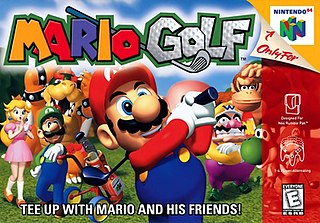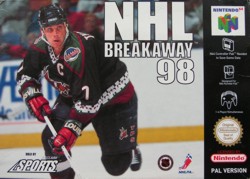
Gauntlet Legends is an arcade game released in 1998 by Atari Games and Midway Games. It is a fantasy themed hack and slash styled dungeon crawl game, a sequel to 1985's popular Gauntlet and 1986's Gauntlet II and marks the final game in the series to be produced by Atari Games. Its unusual features for an arcade game included passwords and characters that could be saved, enabling players to play over the course of a long period.

Cruis'n World is a 1996 racing game developed by Midway Games and published by Nintendo. It is the sequel to the 1994 arcade racer Cruis'n USA. A port for the Nintendo 64 developed by Eurocom was released in 1998, and was the best received of the Cruis'n ports.

NBA Live 99 is the fifth installment of the NBA Live video games series. The cover features Antoine Walker of the Boston Celtics. The game was developed by EA Sports and released on November 4, 1998, for the Nintendo 64, and then on November 10, 1998, for the Windows and PlayStation. Don Poier is the play-by-play announcer. It was the first NBA Live game released for Nintendo 64. NBA Live 99 was followed by NBA Live 2000.

All-Star Baseball 99 is a video game developed by Iguana Entertainment and Realtime Associates Seattle Division and published by Acclaim Entertainment for the Game Boy and the Nintendo 64 in 1998. The game's cover features Colorado Rockies outfielder Larry Walker.

MRC: Multi-Racing Championship is a racing video game developed by Genki and released for the Nintendo 64 in 1997. It was published in North America and Europe by Ocean and in Japan by Imagineer. The game is compatible with the Controller Pak and the Rumble Pak.

BattleTanx is a 1998 action game released for the Nintendo 64, produced by The 3DO Company. The game was followed by a 1999 sequel, titled BattleTanx: Global Assault.

WCW Mayhem is a professional wrestling video game published by Electronic Arts (EA), based on the American promotion World Championship Wrestling (WCW). The first WCW game produced by EA, it was released for Nintendo 64 and PlayStation in 1999 and for the Game Boy Color the following year.

Mario Golf is a 1999 sports game developed by Camelot Software Planning and published by Nintendo for the Nintendo 64. Mario, his friends, and his enemies play golf on a variety of Mario-themed courses. Following NES Open Tournament Golf, it is the second game in the Mario Golf series. Camelot also developed a Game Boy Color version, which adds role-playing elements.

Top Gear Overdrive is a racing game released in 1998 for the Nintendo 64 and the sequel to Top Gear Rally. The game has support for high-resolution graphics if used with the Expansion Pak and features music from the band Grindstone.

Mickey's Speedway USA is a kart racing game developed by Rare and published by Nintendo for the Nintendo 64 and Game Boy Color. It features characters from the Mickey Mouse universe racing across the United States. It is Rare and Nintendo's second collaboration with Disney Interactive following Mickey's Racing Adventure (1999) and Rare's second 3D kart racing game after Diddy Kong Racing (1997).

Nagano Winter Olympics '98, known in Japan as Hyper Olympics in Nagano, is a multi-event sports game from Konami. It is based on the 1998 Winter Olympics and features 10 Olympic events including skating, skiing, luge, bobsleigh, slalom, curling, halfpipe and snowboarding. The game is part of the Track & Field/Hyper Sports series and would be the last licensed Olympic video game released on a Nintendo home console until Mario & Sonic at the Olympic Games about nine years later.

AeroGauge is a hovercraft racing game designed for the Nintendo 64 game console and released in 1998. The game was developed by Locomotive and published by ASCII. It is conceptually similar to Psygnosis' Wipeout or Acclaim's Extreme-G. The main difference is that the vehicles in the game fly instead of hovering. AeroGauge garnered mediocre reviews, with criticism directed at its routine concept, excessive pop up, lack of weapons and power-ups, and overly high difficulty.

Armorines: Project S.W.A.R.M., known as Armorines in Europe, is a 1999 first-person shooter developed by Acclaim Studios London and released for the Nintendo 64, Game Boy Color and PlayStation. It is based on the Armorines comic book from Valiant Comics, which was bought by Acclaim Entertainment.

California Speed is a racing video game developed and published by Atari Games. The game was first released in arcades in 1998 and was ported to the Nintendo 64 in 1999 by Midway. The Nintendo 64 version of the game contains support for the Controller Pak and the Rumble Pak.

Kobe Bryant in NBA Courtside, sometimes mislabeled as Kobe Bryant's NBA Courtside, is a 1998 basketball video game developed by Left Field Productions and published by Nintendo for the Nintendo 64. At the time of the game's release, Kobe Bryant was in his second NBA season and at age 19, was the youngest player to have a game named for him. It was followed by a sequel, NBA Courtside 2 Featuring Kobe Bryant, released in 1999 for the Nintendo 64 and Game Boy Color.

NBA Jam 99 is a basketball game for the Nintendo 64 and Game Boy Color, released in 1998 by Acclaim Entertainment's Acclaim Sports label and developed by Iguana West. New Jersey Nets forward Keith Van Horn appeared on the cover. Acclaim was unable to secure the license to use Michael Jordan's name or likeness, and as such he was not available as a player for the Chicago Bulls. A player named Roster Guard is available in his place. Rosters are accurate as of July 1, 1998. The game also features Kevin Harlan on play-by-play with Bill Walton as the color commentator. The Utah Jazz' Dan Roberts provides the arena announcing.

NHL Blades of Steel '99, known as NHL Pro 99 in Europe, is an ice hockey game for Nintendo 64 and Game Boy Color. The N64 version has Controller Pak and Rumble Pak support. NHL Blades of Steel '99 is the second game in the Blades of Steel series following Blades of Steel for the NES. The third and last game in the series, NHL Blades of Steel 2000, was released for the PlayStation.

NHL Breakaway 98 is a 1997 ice hockey video game for the PlayStation and Nintendo 64. It was the first hockey game to come from Acclaim Entertainment and the first game released under the publisher's new Acclaim Sports label. The game met with divisive reviews upon its release for the PlayStation, though the game's management mode and its system of using points to improve aspects of a team received widespread praise, but reviews for the later Nintendo 64 version were more consistently favorable. It was followed by a sequel, NHL Breakaway 99, released the following year.

Supercross 2000 is a 3D racing game based on the sport of Supercross. It was published by EA Sports for PlayStation and Nintendo 64 consoles in North America on October 31, 1999, and in Europe in February 2000. Its sequel, Supercross, was released in November 2000.

NFL Blitz is an American football video game developed and published by Midway for the arcade in 1997, the first game in the NFL Blitz series. The development team was headed by Mark Turmell and Sal Divita, who were known for being behind NBA Jam, and NFL Blitz was a deliberate attempt to translate the exaggerated arcade-style approach of NBA Jam to the football realm. The game was ported to the PlayStation, Nintendo 64, Windows, and Game Boy Color in 1998. The cover athlete for the game was then Pittsburgh Steelers quarterback Kordell Stewart.




















